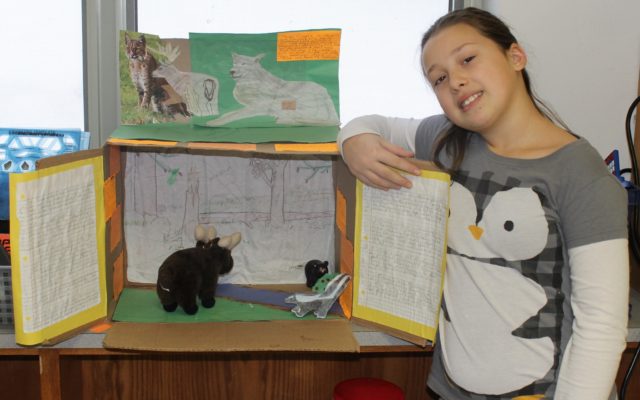
Full STEAM ahead for Guilford area grade 5-6 ecology projects
GUILFORD — Fifth- and sixth-graders at Piscataquis Community Elementary School have been having science, technology, engineering, art and math lessons incorporated into the classroom, utilizing their newly-gained knowledge in a recent ecology unit.
“They have been working on their ecosystem projects with Mr. Gregoy’s class,” Principal Anita Wright said.
Grade 5/6 teacher Alden Gregory said in an approximate four-week unit students learned about ecosystems and biomes and how energy moves between the organisms in each. Gregory students randomly drew the name of an ecosystem or biome, for grade 6 and grade 5 respectively, and then built a model of their environment using STEAM skills.
An ecosystem is defined as the interaction between living species and non-living components of an environment, and a biome is a specific geographic area characterized by the species living there. A biome can be up made up of multiple ecosystems.
Gregory said many students opted to create a traditional model in a box and one created an electronic model. He said the ecosystems and biomes included several examples of producing and consuming species.
“You would be surprised at how creative they are, one girl built a big horn elk out of clay,” Gregory said, holding up the figure. He said the students got excited about their models, talking with their peers as they worked over and eager to show each other the finished products.
“I did a Maine forest,” sixth-grader Gabbie Cote said in showing her ecosystem project made in about a week. The model included a toy moose and bear and a paper skunk she made, and as well as drawings of a wolf and deer and a picture of a bobcat. Cote drew a forest scene and wrote project explanations for onlookers to read.
Cote said sunlight is captured by flowers and trees and these plants are then eaten by herbivores and omnivores. She said the species then become prey for predators, and after death the bodies of predators fertilize the plant life. “It goes through a process where they keep getting nutrients,” Cote said about the natural cycle of life.
She said in addition to predatory relationships, she also learned about parasitic relationships among species. Cote showed this by drawing a diagram featuring a tapeworm inside her wolf.
Observer photo/Stuart Hedstrom
MAINE FOREST ECOSYSTEM — Piscataquis Community Elementary School sixth-grader Gabbie Cote created a model of a Maine forest for her ecosystem project. Using science, technology, engineering, art and math (STEAM) lessons students in Alden Gregory’s grade 5-6 classes at the Guilford school replicated an ecosystem or biome and demonstrated the relationships between the various species living in each.
